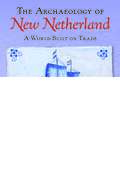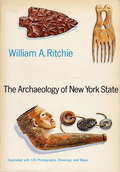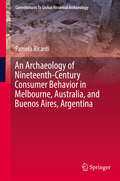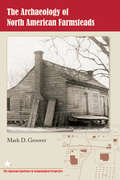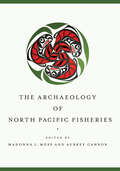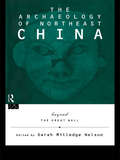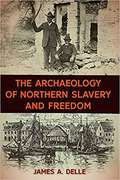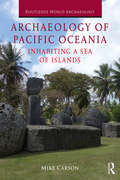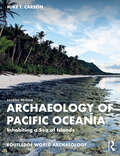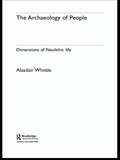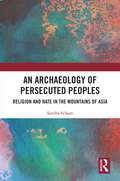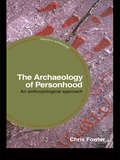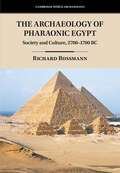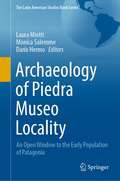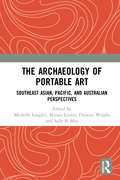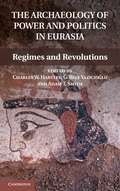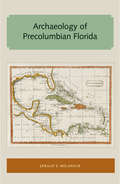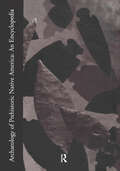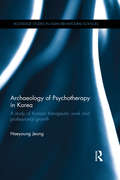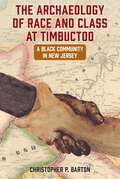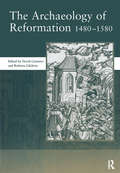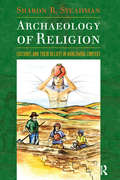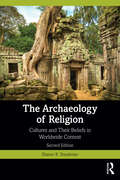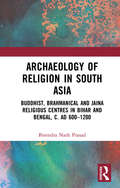- Table View
- List View
The Archaeology of New Netherland: A World Built on Trade
by Craig Lukezic John P. McCarthyUncovering the material culture of Dutch colonization in North America The Archaeology of New Netherland illuminates the influence of the Dutch empire in North America, assembling evidence from seventeenth-century settlements located in present-day New York, New Jersey, Connecticut, Pennsylvania, and Delaware. Archaeological data from this important early colony has often been overlooked because it lies underneath major urban and industrial regions, and this collection makes a wealth of information widely available for the first time. Contributors to this volume begin by discussing the global context of Dutch colonization and reviewing typical Dutch material culture of the time as seen in ceramics from Amsterdam households. Next, they focus on communities and activities at colonial sites such as forts, trading stations, drinking houses, and farms. The essays examine the agency and impact of Indigenous people and enslaved Africans, particularly women, in the society of New Netherland, and they trace interactions between Dutch settlers and Europeans from other colonies including New Sweden. The volume also features landmark studies of cooking pots, marbles, tobacco pipes, and other artifacts. The research in this volume offers an invitation to investigate New Netherland with the same sustained rigor that archaeologists and historians have shown for English colonialism. The many topics outlined here will serve as starting points for further work on early Dutch expansion in America. Contributors: Craig Lukezic | John P. McCarthy | Charles Gehring | Marijn Stolk | Ian Burrow | Adam Luscier | Matthew Kirk | Michael T. Lucas | Kristina S. Traudt | Marie-Lorraine Pipes | Anne-Marie Cantwell | Diana diZerega Wall | Lu Ann De Cunzo | Wade P. Catts | William B. Liebeknecht | Marshall Joseph Becker | Meta F. Janowitz | Richard G. Schaefer | Paul R. Huey | David A. Furlow
The Archaeology of New York State
by William A. RitchieThe most complete account of ancient man in the New York area ever published in one volume, this book traces a rich, 8000-year story of human prehistory. Beginning with the first known inhabitants, Paleo-Indian hunters who lived approximately 7000 B.C., the author gives a detailed chronological account of the complex of cultural units that have existed in the area, culminating in the Iroquois tribes encountered by the European colonists at the dawn of the seventeenth century. All of the major archaeological sites in the region are described in detail and representative artifacts from all the major cultural units are illustrated in over 100 plates and drawings. The entire account is informed by the most recently obtained radio-carbon dates. In addition to giving much new, previously unpublished information, the author has synthesized all earlier published material and from this he has drawn as many inferences as the material affords regarding the nature of these early inhabitants, where they came from, and how they lived. Each cultural unit is systematically described: its discovery and naming; its ecological and chronological setting; the physical characteristics of the related people; economy; housing and settlement pattern; dress and ornament; technology; transportation; trade relationships; warfare; esthetic and recreational activities; social and political organization; mortuary customs; and religio-magical and ceremonial customs.
An Archaeology of Nineteenth-Century Consumer Behavior in Melbourne, Australia, and Buenos Aires, Argentina (Contributions To Global Historical Archaeology)
by Pamela RicardiThis book compares consumer behavior in two nineteenth-century peripheral cities: Melbourne, Australia and Buenos Aires, Argentina. It provides an analysis of domestic archaeological assemblages from two inner-city working class neighborhood sites that were largely populated by recently arrived immigrants.The book also uses primary, historical documents to assess the place of these cities within global trade networks and explores the types of goods arriving into each city. By comparing the assemblages and archival data it is possible to explore the role of choice, ethnicity, and class on consumer behavior. This approach is significant as it provides an archaeological assessment of consumer behavior which crosses socio-political divides, comparing a site within a British colony to a site in a former Spanish colony in South America. As two geographically, politically and ethnically distinct cities it was expected that archaeological and archival data would reveal substantial variation. In reality, differences, although noted, were small. Broad similarities point to the far-reaching impact of colonialism and consumerism and widespread interconnectedness during the nineteenth century. This book demonstrates the wealth of information that can be gained from international comparisons that include sites outside the British Empire.
The Archaeology of North American Farmsteads (American Experience in Archaeological Pespective)
by Mark D. GrooverFrom the early colonial period to the close of World War II, life in North America was predominantly agrarian and rural. Archaeological exploration of farmsteads unveils a surprising quantity of data about rural life, consumption patterns, and migrations across the continent.Mark Groover offers both case studies and an overview of current trends in farmstead archaeology in this exciting new work. He also proposes a research design and makes numerous suggestions for evaluating (and re-evaluating) the significance of farmsteads as an archaeological resource. His chronological survey of farmstead sites throughout numerous regions of North America provides fascinating insights to students, cultural resource management professionals, or general readers interested in learning more about what material culture remains can teach us about the American past.Farmstead archaeology is a rapidly expanding component of historical archaeology. This book offers important lessons and information as more sites become victims of ever-accelerating development and urbanization.
The Archaeology of North Pacific Fisheries
by Moss, Madonna L.; Cannon, AubreyFor thousands of years, fisheries were crucial to the sustenance of the First Peoples of the Pacific Coast. Yet human impact has left us with a woefully incomplete understanding of their histories prior to the industrial era. Covering Alaska, British Columbia, and Puget Sound, The Archaeology of North Pacific Fisheries illustrates how the archaeological record reveals new information about ancient ways of life and the histories of key species. Individual chapters cover salmon, as well as a number of lesser-known species abundant in archaeological sites, including pacific cod, herring, rockfish, eulachon, and hake. In turn, this ecological history informs suggestions for sustainable fishing in today’s rapidly changing environment.
The Archaeology of Northeast China: Beyond the Great Wall
by Sarah Milledge NelsonAn up-to-date synthesis of the archaeology and prehistory of the region called Dongbei by the Chinese, but known in the west as Manchuria. Based on recent archaeological discoveries, the book presents evidence to show that far from being a backwater palely reflecting the glories of central China, Manchuria in prehistory had both its own developmental trajectory, parallel to but different from that of China, and contributed to the formation of the characteristics of what came to be Chinese. New information on the Northeast region of China indicates that it was not populated exclusively by nomadic peoples, but that some of the earliest farming sites can be found here. The Hongshan culture with its Goddess Temple and female figurines is unique, with spectacular and unprecedented jade carving. Lower Xiajiadian culture has painted pottery that can be seen to be the forerunner to the magnificent Shang bronzes.
The Archaeology of Northern Slavery and Freedom (The American Experience in Archaeological Perspective)
by James A. DelleInvestigating what life was like for African Americans north of the Mason-Dixon Line during the eighteenth and nineteenth centuries, James Delle presents the first overview of archaeological research on the topic in this book, debunking the notion that the “free” states of the Northeast truly offered freedom and safety for African Americans. <p><p> Excavations at cities including New York and Philadelphia reveal that slavery was a crucial part of the expansion of urban life as late as the 1840s. Slaves cleared forests, loaded and unloaded ships, and manufactured charcoal to fuel iron furnaces. The case studies in this book also show that enslaved African-descended people frequently staffed suburban manor houses and agricultural plantations. Moreover, for free blacks, racist laws such as the Fugitive Slave Act of 1850 limited the experience of freedom in the region. Delle explains how members of the African diaspora created rural communities of their own and worked in active resistance against the institution of slavery, assisting slaves seeking refuge and at times engaging in violent conflicts. The book concludes with a discussion on the importance of commemorating these archaeological sites, as they reveal an important yet overlooked chapter in African American history. <p><p> Delle shows that archaeology can challenge dominant historical narratives by recovering material artifacts that express the agency of their makers and users, many of whom were written out of the documentary record. Emphasizing that race-based slavery began in the Northeast and persisted there for nearly two centuries, this book corrects histories that have been whitewashed and forgotten.
Archaeology of Pacific Oceania: Inhabiting a Sea of Islands (Routledge World Archaeology)
by Mike T. CarsonThis book integrates a region-wide chronological narrative of the archaeology of Pacific Oceania. How and why did this vast sea of islands, covering nearly one-third of the world’s surface, come to be inhabited over the last several millennia, transcending significant change in ecology, demography, and society? What can any or all of the thousands of islands offer as ideal model systems toward comprehending globally significant issues of human-environment relations and coping with changing circumstances of natural and cultural history? A new synthesis of Pacific Oceanic archaeology addresses these questions, based largely on the author’s investigations throughout the diverse region.
Archaeology of Pacific Oceania: Inhabiting a Sea of Islands (Routledge World Archaeology)
by Mike T. CarsonArchaeology of Pacific Oceania, now in its second edition, offers a state-of-the-art and fully detailed chronological narrative of how Pacific Oceania came to be inhabited over a long time scale, posing fundamental questions both for Pacific Oceania and for global archaeology. The Pacific Ocean covers 165 million sq. km, nearly one-third of the world’s total surface area, yet its thousands of islands and their diverse cultural histories are scarcely known to the other two-thirds of the world. This book asks how and why did this vast sea of islands come to be inhabited over the last several millennia, transcending significant change in ecology, demography, and society? What were the roles of overseas contacts in the development of social networks, economic trade, and population dynamics? What can any or all of the thousands of islands offer as ideal model systems for comprehending globally significant issues of human-environment relations and coping with changing circumstances of natural and cultural history? What do the island archaeology records reveal about coastal setting as part of the larger human experience? How does Pacific Oceanic archaeology relate with a larger Asia-Pacific context or with the scope of world archaeology? The new second edition of Archaeology of Pacific Oceania addresses these questions and more, providing an updated synthesis of this important region. Archaeology of Pacific Oceania is for scholars of Asia-Pacific archaeology and anthropology and will support students investigating the archaeology of Pacific Oceania.
The Archaeology of People: Dimensions of Neolithic Life
by Alisdair WhittleAlasdair Whittle's new work argues powerfully for the complexity and fluidity of life in the Neolithic, through a combination of archaeological and anthropological case studies and current theoretical debate. The book ranges from the sixth to the fourth millennium BC, and from the Great Hungarian Plain, central and western Europe and the Alpine foreland to parts of southern Britain. Familiar terms such as individuals, agency, identity and structure are dealt with, but Professor Whittle emphasises that they are too abstract to be truly useful.Instead, he highlights the multiple dimensions which constituted Neolithic existence: the web of daily routines, group and individual identities, relations with animals, and active but varied attitudes to the past. The result is a vivid, original and perceptive understanding of the early Neolithic which will offer insights to readers at every level.
An Archaeology of Persecuted Peoples: Religion and Hate in the Mountains of Asia
by Sandra SchamThis book examines the pasts and presents of some of the world’s most persecuted peoples, in search of answers to the question of why minorities living in Asia’s Highlands, with ancient roots in their homelands, have been continually oppressed by both historical and modern governments. The role of religious beliefs and practices is crucial to their story of isolation, tenacity, and resistance in the mountains of Asia. The Rohingya, Uyghurs, Hazara, Yazidis, Armenians, and Samaritans were among the earliest adopters of monotheist religions in their respective regions. The chapters devoted to each of these ethno-religious minorities explore the archaeological evidence for their millennia-old presence in South, East, and West Asia, their historical trajectories, and the more recent events that have decimated their populations and destroyed their ways of living. Examining both the parochial and universalist roots of their beliefs and practices as they evolved from the Axial Age teachings of Zoroaster, the Israelite prophets, and Ancient Greek philosophers, this book explains how the people of the Arakan, Tienshan, Hazarajat, Sinjar, Tauru,s and Gerizim mountains came to be regarded as perennial enemies of empires and nations.
The Archaeology of Personhood: An Anthropological Approach
by Chris FowlerBringing together a wealth of research in social and cultural anthropology, philosophy and related fields, this is the first book to address the contribution that an understanding of personhood can make to our interpretations of the past Applying an anthropological approach to detailed case studies from European prehistoric archaeology, the book explores the connection between people, animals, objects, their societies and environments and investigates the relationship that jointly produces bodies, persons, communities and artefacts. The Archaeology of Personhood examines the characteristics that define a person as a category of being, highlights how definitions of personhood are culturally variable and explores how that variation is connected to human uses of material culture.
The Archaeology of Pharaonic Egypt: Society and Culture, 2700–1700 BC (Cambridge World Archaeology)
by Richard BussmannIn this book, Richard Bussmann presents a fresh overview of ancient Egyptian society and culture in the age of the pyramids. He addresses key themes in the comparative research of early complex societies, including urbanism, funerary culture, temple ritual, kingship, and the state, and explores how ideas and practices were exchanged between ruling elites and local communities in provincial Egypt. Unlike other studies of ancient Egypt, this book adopts an anthropological approach that places people at the centre of the analysis. Bussmann covers a range of important themes in cross-cultural debates, such as materiality, gender, non-elite culture, and the body. He also offers new perspectives on social diversity and cultural cohesion, based on recent discoveries. His study vividly illustrates how our understanding of ancient Egyptian society benefits from the application of theoretical concepts in archaeology and anthropology to the interpretation of the evidence.
Archaeology of Piedra Museo Locality: An Open Window to the Early Population of Patagonia (The Latin American Studies Book Series)
by Laura Miotti Monica Salemme Darío HermoThis book highlights the knowledge about landscapes and characteristics of the earliest hunter-gatherer lifeway in Southern Patagonia. It presents an analysis of the archaeological investigations carried out during three decades by an interdisciplinary team that involved archaeologists, anthropologists, paleontologists, geologists and specialists in pollen and diatoms. The database yielded was recovered from systematic survey and excavations from the Pleistocene and Holocene stratigraphic layers of the rockshelter known as AEP-1, Piedra Museo Locality, situated in the central plateau of Santa Cruz Province, Argentina. Piedra Museo is a unique place in the world of high academic interest with some of the earliest archaeological remains in the Americas. Researchers defined two strata and several Stratigraphic units in the site based on the sedimentological and pedological characteristics. The depositional zones contain archaeological remains that are interpreted as hunting events corresponding to two main different occasions in the human colonization of the region, and a third human occupation during the Middle Holocene. Last one occurred then of the massive rockshelter roof colapse. The faunal remains led to a new approach to the palaeoenvironmental evolution of this enclosed basin. This volume describes the management of lithic raw materials and social networks from first human occupation of the Patagonian region to territorial consolidation of hunter-gatherer societies.
The Archaeology of Portable Art: Southeast Asian, Pacific, and Australian Perspectives
by Michelle Langley Mirani Litster Duncan Wright Sally K MayThe development of complex cultural behaviour in our own species is perhaps the most significant research issue in modern archaeology. Until recently, it was believed that our capacity for language and art only developed after some of our ancestors reached Europe around 40,000 years ago. Archaeological discoveries in Africa now show that modern humans were practicing symbolic behaviours prior to their dispersal from that continent, and more recent discoveries in Indonesia and Australia are once again challenging ideas about human cultural development. Despite these significant discoveries and exciting potentials, there is a curious absence of published information about Asia-Pacific region, and consequently, global narratives of our most celebrated cognitive accomplishment — art — has consistently underrepresented the contribution of Southeast Asia, Australia, and the Pacific Islands. This volume provides the first outline of what this region has to offer to the world of art in archaeology. Readers undertaking tertiary archaeology courses interested in the art of the Asia-Pacific region or human behavioural evolution, along with anyone who is fascinated by the development of our modern ability to decorate ourselves and our world, should find this book a good addition to their library.
The Archaeology of Power and Politics in Eurasia: Regimes and Revolutions
by G. Bike Yazicioğlu Charles W. Hartley Adam T. SmithFor thousands of years, the geography of Eurasia has facilitated travel, conquest and colonization by various groups, from the Huns in ancient times to the Union of Soviet Socialist Republics in the past century. This book brings together archaeological investigations of Eurasian regimes and revolutions ranging from the Bronze Age to the modern day, from Eastern Europe and the Caucasus in the west to the Mongolian steppe and the Korean Peninsula in the east. The authors examine a wide-ranging series of archaeological studies in order to better understand the role of politics in the history and prehistory of the region. This book re-evaluates the significance of power, authority and ideology in the emergence and transformation of ancient and modern societies in this vast continent.
Archaeology of Precolumbian Florida (Florida and the Caribbean Open Books Series)
by Jerald T. MilanichThe books in the Florida and the Caribbean Open Books Series demonstrate the University Press of Florida’s long history of publishing Latin American and Caribbean studies titles that connect in and through Florida, highlighting the connections between the Sunshine State and its neighboring islands. Books in this series show how early explorers found and settled Florida and the Caribbean. They tell the tales of early pioneers, both foreign and domestic. They examine topics critical to the area such as travel, migration, economic opportunity, and tourism. They look at the growth of Florida and the Caribbean and the attendant pressures on the environment, culture, urban development, and the movement of peoples, both forced and voluntary. The Florida and the Caribbean Open Books Series gathers the rich data available in these architectural, archaeological, cultural, and historical works, as well as the travelogues and naturalists’ sketches of the area in prior to the twentieth century, making it accessible for scholars and the general public alike. The Florida and the Caribbean Open Books Series is made possible through a grant from the National Endowment for the Humanities and the Andrew W. Mellon Foundation, under the Humanities Open Books program.
The Archaeology of Prehistoric Arabia
by Peter MageeEncompassing a landmass greater than the rest of the Near East and Eastern Mediterranean combined, the Arabian peninsula remains one of the last great unexplored regions of the ancient world. This book provides the first extensive coverage of the archaeology of this region from c. 9000 to 800 BC. Peter Magee argues that a unique social system, which relied on social cohesion and actively resisted the hierarchical structures of adjacent states, emerged during the Neolithic and continued to contour society for millennia later. The book also focuses on how the historical context in which Near Eastern archaeology was codified has led to a skewed understanding of the multiplicity of lifeways pursued by ancient peoples living throughout the Middle East.
Archaeology of Prehistoric Native America: An Encyclopedia
by Guy GibbonFirst published in 1998. Did prehistoric humans walk to North America from Siberia? Who were the inhabitants of the spectacular Anasazi cliff dwellings in the Southwest and why did they disappear? Native Americans used acorns as a major food source, but how did they get rid of the tannic acid which is toxic to humans? How does radiocarbon dating work and how accurate is it? Written for the informed lay person, college-level student, and professional, Archaeology of Prehistoric Native America: An Encyclopedia is an important resource for the study of the earliest North Americans; including facts, theories, descriptions, and speculations on the ancient nomads and hunter-gathers that populated continental North America.
Archaeology of Psychotherapy in Korea: A study of Korean therapeutic work and professional growth (Routledge Studies in Asian Behavioural Sciences)
by Haeyoung JeongThis is the first English book dedicated solely to the historical development of psychotherapy in Korea. It is an archaeological research of literature relating to the care and treatment of mind in Korean history in dialogue with spiritual, philosophical, cultural, social, and medical perspectives. It reviews the evolution of different approaches on mental illnesses covering autochthonous practices, psychiatry, clinical psychology, counseling, Western psychotherapy, and Korean psychotherapy. Archaeology of Psychotherapy in Korea inspects: Folk Treatment First Psychiatry Influence from Clinical Psychology Counselling Development Implementation of Western Psychotherapy Shaping of Korean Psychotherapy Its discussion engages firmly with the Korean culture and perspective while acknowledging various extrinsic influences and the fact that Korean psychotherapy continues to evolve in its own unique manner. It aims to refine the understanding of psychotherapy development in Korea in connection with its historical and social backgrounds, and to interpret a way to highlight the culturally relevant psychotherapy that is more suitable as a Korean psychotherapy better attuned to the distinct cultural and societal expectation of Korea.
The Archaeology of Race and Class at Timbuctoo: A Black Community in New Jersey
by Christopher P. BartonCollaborative archaeology and the lasting character of a historic Black community The Archaeology of Race and Class at Timbuctoo is the first book to examine the historic Black community of Timbuctoo, New Jersey, which was founded in 1826 by formerly enslaved migrants from Maryland and served as a stop on the Underground Railroad. In collaboration with descendants and community members, Christopher Barton explores the intersectionality of life at Timbuctoo and the ways Black residents resisted the marginalizing structures of race and class. Despite some support from local Quaker abolitionists, the people of Timbuctoo endured strained relationships with neighboring white communities, clashes with slave catchers, and hostilities from the Ku Klux Klan. Through a multiscalar approach that ranges from landscape archaeology and settlement patterns to analysis of consumer artifacts, this book demonstrates how residents persevered to construct their own identities and navigate poverty. Barton incorporates oral histories from community elders that offer insights into the racial tensions of the early- to mid-twentieth century and convey the strong, lasting character of the community in the face of repression. Weaving together memories and inherited accounts, current archaeological investigations, historical records, and comparisons to nearby Black-established communities of the era, this book illuminates the everyday impacts of slavery and race relations in a part of the country that seemed to promise freedom and highlights the use of archaeology as a medium for social activism.Publication of this work made possible by a Sustaining the Humanities through the American Rescue Plan grant from the National Endowment for the Humanities.
The Archaeology of Reformation,1480-1580 (The\society For Post-medieval Archaeology Monographs)
by David GaimsterTraditionally the Reformation has been viewed as responsible for the rupture of the medieval order and the foundation of modern society. Recently historians have challenged the stereotypical model of cataclysm, and demonstrated that the religion of Tudor England was full of both continuities and adaptations of traditional liturgy, ritual and devoti
Archaeology of Religion: Cultures and their Beliefs in Worldwide Context
by Sharon R SteadmanSteadman fills an empty niche in the offerings on how archaeology interprets past religions with this useful textbook. The book includes case studies from around the world, from the study of Upper Paleolithic religions and of shamans in foraging societies to formal religious structures in advanced complex societies of Mesopotamia, Egypt, India and the Andes. Steadman also includes key contemporary religions—Christianity, Islam, and Buddhism, among others—to provide an historical and comparative context. This is an ideal text for a archaeology of religion courses and classes that include a significant component on “past religions,” as well as an excellent guide for general readers.
The Archaeology of Religion: Cultures and Their Beliefs in Worldwide Context
by Sharon R. SteadmanThe new and updated edition of The Archaeology of Religion explores how archaeology interprets past religions, offering insights into how archaeologists seek out the religious, ritual, and symbolic meaning behind what they discover in their research. The book includes case studies from around the world, from the study of Upper Palaeolithic and hunter-gatherer religions to religious structures and practices in complex societies of the Americas, Mesopotamia, Egypt, India, and China. Steadman also includes chapters on the origins and development of key contemporary religions—Judaism, Christianity, Islam, among others—to provide an historical and comparative context. Three main themes are threaded throughout the book. These main themes involve the intersection between cultural and religious structures (“religion reflects culture”), including the importance of environment in shaping a culture’s religion, the role religion can sometimes play as a method of social control, and the role religion can sometimes play as a key component in revitalizing a culture. Updated with new discoveries and theories and with two new chapters (Hunter-Gatherer Religions; and Cultures in East Asia) and with new sections on Neolithic Western Asia, the book remains an ideal introduction for courses that include a significant component on past cultures and their religions.
Archaeology of Religion in South Asia: Buddhist, Brahmanical and Jaina Religious Centres in Bihar and Bengal, c. AD 600–1200
by Birendra Nath PrasadIn the religious landscape of early medieval (c. AD 600-1200) Bihar and Bengal, poly-religiosity was generally the norm than an exception, which entailed the evolution of complex patterns of inter-religious equations. Buddhism, Brahmanism and Jainism not only coexisted but also competed for social patronage, forcing them to enter into complex interactions with social institutions and processes. Through an analysis of the published archaeological data, this work explores some aspects of the social history of Buddhist, Brahmanical and Jaina temples and shrines, and Buddhist stūpas and monasteries in early medieval Bihar and Bengal. This archaeological history of religions questions many ‘established’ textual reconstructions, and enriches our understanding of the complex issue of the decline of Buddhism in this area. Please note: Taylor & Francis does not sell or distribute the Hardback in India, Pakistan, Nepal, Bhutan, Bangladesh and Sri Lanka.
